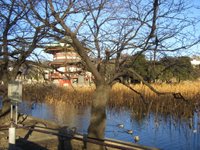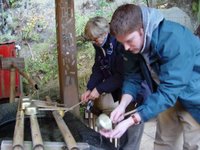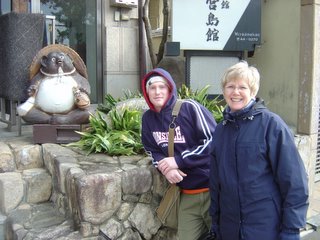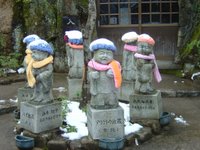Nippon News Volume 2 Issue 1

Boxing Day was sunny but cool and crips with temperatures around zero celcius. Scott an
 d Della joined Sandra, Jay, Jean and myself for a tour of the Akrihabra and Ueno areas of downtown Toyko. Uneo features a very nice park with shrines, and the residence (which we toured) in which Douglas MacArthur ruled post-war Japan and in which the Constitution was drafted. Akihabara has a huge electronics area and features some of the classic night-scenes of this booming metropolis. Along the way we managed to squeeze in a visit to a Ramen Shop for another fabulous meal, (pictured above).
d Della joined Sandra, Jay, Jean and myself for a tour of the Akrihabra and Ueno areas of downtown Toyko. Uneo features a very nice park with shrines, and the residence (which we toured) in which Douglas MacArthur ruled post-war Japan and in which the Constitution was drafted. Akihabara has a huge electronics area and features some of the classic night-scenes of this booming metropolis. Along the way we managed to squeeze in a visit to a Ramen Shop for another fabulous meal, (pictured above).With Boxing Day out of the way, we were back out on the road the
 next day to see the sights and learn more about his amazing country. First item on the agenda; - a river cruise right through the heart of downtown Tokyo to get the feel of the city and to see what this part of town was like. The boat was part Sampan, part Paula D (for you Ottawa Folks you will know that name); a funky, let's say, mature, craft that was spacious, comfortable, and an entirely civilized way to go (or so the guy at the boarding ramp said, leaving me to assess his level of comfort with the English Language so that I could judge what exactly he meant by the words '.. a great way to go'.
next day to see the sights and learn more about his amazing country. First item on the agenda; - a river cruise right through the heart of downtown Tokyo to get the feel of the city and to see what this part of town was like. The boat was part Sampan, part Paula D (for you Ottawa Folks you will know that name); a funky, let's say, mature, craft that was spacious, comfortable, and an entirely civilized way to go (or so the guy at the boarding ramp said, leaving me to assess his level of comfort with the English Language so that I could judge what exactly he meant by the words '.. a great way to go'.Unfortunately, I was disappointed to find that the crew had locked the door to the upper deck, but within minutes I disc
 overed why. Many of the bridges that we slipped under on our way had clearances measured in inches, so anyone on the upper deck would have been quickly swept aside! However, inside the view was good, the cabin crew were young and enthusiastic, and they had a variety of drinks and food available for anyone who was interested. Scott and Della both had a taste of Sake, Japanese Rice Wine, and while it was a very different flavour, they both stuck to beer thereafter.
overed why. Many of the bridges that we slipped under on our way had clearances measured in inches, so anyone on the upper deck would have been quickly swept aside! However, inside the view was good, the cabin crew were young and enthusiastic, and they had a variety of drinks and food available for anyone who was interested. Scott and Della both had a taste of Sake, Japanese Rice Wine, and while it was a very different flavour, they both stuck to beer thereafter.We cruised past the Tokyo Fish Market, past high-rise buildings and past office towers both traditional and strange. Homeless people will put up tarps along the banks of the rivers, where they live in quiet, not bothering anyone. Come to think of it, in my seven weeks in Japan, I have never seen a single panhandler, other than a Shinto Monk dressed in robes and sandels and wearing the unique conical straw hat that signifies his sect. The Monk was in a group of perhaps four others who were standing on a major bridge in Kyoto, holding out their begging bowls to the passerbys, but not saying or doing anything to the passers-by.
After about an hour cruise, we docked on the north end of the downtown area,
 right across from a major landmark building that the locals call The Golden Turd. We then walked to a major shrine and temple that is in the area. Here again the familiar purification, praying and penance rituals were taking place all around us. However, I did note one significant addition to the entertainment at the Shrine; the Fortune Stick Dispenser. This was a hexigon-shaped silver box about 12" inches high. Putting a coin into the offering box, (a 100-yen coin is the going rate) one then picks up the dispenser with a good shake, and then rotates it until a small wooden dowel appears in the small hole in the bottom. One can then extract the stick, on which are written words in Japanese. Using these symbols, one then searches a bank of about 100 drawers located directly behind the table on which the Dispenser stands, until you find the one corresponding to the markings on your Fortune Stick. Opening the drawer you then extract the sheet of paper inside the little drawer, and it contains your fortune.
right across from a major landmark building that the locals call The Golden Turd. We then walked to a major shrine and temple that is in the area. Here again the familiar purification, praying and penance rituals were taking place all around us. However, I did note one significant addition to the entertainment at the Shrine; the Fortune Stick Dispenser. This was a hexigon-shaped silver box about 12" inches high. Putting a coin into the offering box, (a 100-yen coin is the going rate) one then picks up the dispenser with a good shake, and then rotates it until a small wooden dowel appears in the small hole in the bottom. One can then extract the stick, on which are written words in Japanese. Using these symbols, one then searches a bank of about 100 drawers located directly behind the table on which the Dispenser stands, until you find the one corresponding to the markings on your Fortune Stick. Opening the drawer you then extract the sheet of paper inside the little drawer, and it contains your fortune.Ever efficient, the Japanese have conveniently graded the contents into Good, Average and Bad Fortune. Most of us will now enjoy Good Fortune, with the exception of Jean, who got a Bad Fortune. However, the clever Japanese have thought of that eventuality, too. Anyone who does not like their fortune
 can tie it to a nearby rack and send it straight back to the Gods! Then, for the remarkably low price of another 100-yen coin, one can then extract a new Fortune.
can tie it to a nearby rack and send it straight back to the Gods! Then, for the remarkably low price of another 100-yen coin, one can then extract a new Fortune.After a traditional Japanese Lunch we shopped; Scott buying a Kimono for a gift and Della one for herself. Meanwhile, we were busy inspecting the local stalls and shops and buying some of the Icons found at the end of this article. That evening we returned home late, tired but happy.
The next day we we off on the train south of Tokyo to Kamakura; home of the Big Buddha statue of considerable fame. But first, we stopped at a shrine famous for the washing of your money. The be
 lief is that if you douse your money in its sacred waters it will double. Jay, ever the schemer, promptly washed not only his coins and notes, but also his credit card! However, some of us think that this will only double his debt!!
lief is that if you douse your money in its sacred waters it will double. Jay, ever the schemer, promptly washed not only his coins and notes, but also his credit card! However, some of us think that this will only double his debt!!A walk thought a hilly bamboo forest brought us to the Big Buddha, which was built in the 12th century. Originally it was housed inside a temple, but that was washed away by a massive
 Tsuanami a few centuries ago. (Makes one shudder, especially when you know this is about a half a mile from the ocean, yet our home in Sidney is just two short blocks from the water!). That evening we stopped on the way home to sample Shabu-Shabu; sort of a Japanese version of a Swiss Fondue. Meats and vegetables are dipped into cauldron of boiling water before eating. The more one eats and the greater the variety of food consumed, the more intense the flavour!
Tsuanami a few centuries ago. (Makes one shudder, especially when you know this is about a half a mile from the ocean, yet our home in Sidney is just two short blocks from the water!). That evening we stopped on the way home to sample Shabu-Shabu; sort of a Japanese version of a Swiss Fondue. Meats and vegetables are dipped into cauldron of boiling water before eating. The more one eats and the greater the variety of food consumed, the more intense the flavour!The next two days Della and Scott were off visiting friends of theirs in the area, climbing an active volcano, and sampling such local delicacies as sulpher-blackened eggs, bbq tongue, sashimi (slices of raw fish), and even raw horsemeat!! We, on the other hand, took the opportunity to recover from the torrid pace, catch up on e-mail and get ready for New Years Eve. (this will be the subject of the next issue).
Meanwhile, we had discovered that Japan is very superstitious in their beliefs, and have a large number of icons that are commonly seen when out and about.
ICONS spotted on the way:
 The Waving Kitty. A strangle looking cat with one hand waving is seen everywhere. It was even the subject of the hit computer game, Hello Kitty. Available in all sizes and shaped. We have finally determined that the cat is a lucky symbol and is especially favoured by business establishements, who believe it to be an essential component to its success in the marketplace. If the left hand is waving, it symbolizes the customer, (i.e. will attract them). If the right hand is waving, it means money!
The Waving Kitty. A strangle looking cat with one hand waving is seen everywhere. It was even the subject of the hit computer game, Hello Kitty. Available in all sizes and shaped. We have finally determined that the cat is a lucky symbol and is especially favoured by business establishements, who believe it to be an essential component to its success in the marketplace. If the left hand is waving, it symbolizes the customer, (i.e. will attract them). If the right hand is waving, it means money!- The Raccoon Dog (Chidgodo; we k
 now this as the Badger) - for a while this strange creature puzzled us, since it was only seen in front of restaurants. However, it turns out that in Japanese mythology, the creature protects people from Fire and Robbery, and is a God of Entertainment. Hence, it is a really good insurance policy for bars and restaurants - in fact, there is even a shrine to Chidgodo in Askusa; which we visited.
now this as the Badger) - for a while this strange creature puzzled us, since it was only seen in front of restaurants. However, it turns out that in Japanese mythology, the creature protects people from Fire and Robbery, and is a God of Entertainment. Hence, it is a really good insurance policy for bars and restaurants - in fact, there is even a shrine to Chidgodo in Askusa; which we visited. - Jizo Statues - these icons are an essential part of Buddhist tradition, and are usually Red Bibbed, but this sect on the island just offshore from Hiros
 hima had a slightly different take on the matter.
hima had a slightly different take on the matter.
Anyway, that is it for the moment, but there is always more to come!
Doug-san In Japan
saying Sayonara for now!!

0 Comments:
Post a Comment
<< Home